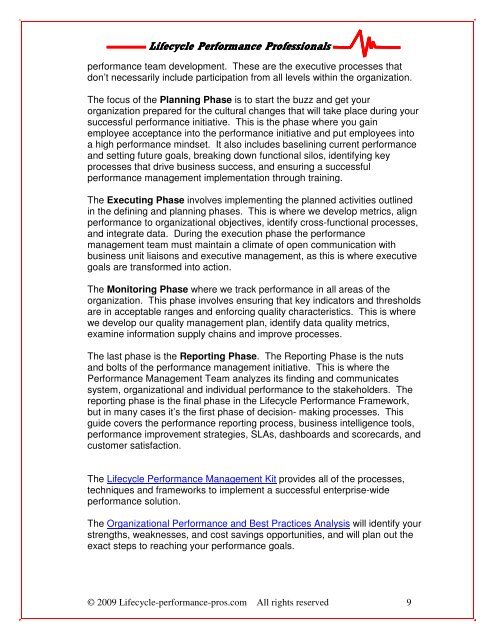Download the Performance Management Fundamentals Guide
Download the Performance Management Fundamentals Guide
Download the Performance Management Fundamentals Guide
You also want an ePaper? Increase the reach of your titles
YUMPU automatically turns print PDFs into web optimized ePapers that Google loves.
Lifecycle Lifecycle <strong>Performance</strong> <strong>Performance</strong> Professionals<br />
Professionals<br />
performance team development. These are <strong>the</strong> executive processes that<br />
don’t necessarily include participation from all levels within <strong>the</strong> organization.<br />
The focus of <strong>the</strong> Planning Phase is to start <strong>the</strong> buzz and get your<br />
organization prepared for <strong>the</strong> cultural changes that will take place during your<br />
successful performance initiative. This is <strong>the</strong> phase where you gain<br />
employee acceptance into <strong>the</strong> performance initiative and put employees into<br />
a high performance mindset. It also includes baselining current performance<br />
and setting future goals, breaking down functional silos, identifying key<br />
processes that drive business success, and ensuring a successful<br />
performance management implementation through training.<br />
The Executing Phase involves implementing <strong>the</strong> planned activities outlined<br />
in <strong>the</strong> defining and planning phases. This is where we develop metrics, align<br />
performance to organizational objectives, identify cross-functional processes,<br />
and integrate data. During <strong>the</strong> execution phase <strong>the</strong> performance<br />
management team must maintain a climate of open communication with<br />
business unit liaisons and executive management, as this is where executive<br />
goals are transformed into action.<br />
The Monitoring Phase where we track performance in all areas of <strong>the</strong><br />
organization. This phase involves ensuring that key indicators and thresholds<br />
are in acceptable ranges and enforcing quality characteristics. This is where<br />
we develop our quality management plan, identify data quality metrics,<br />
examine information supply chains and improve processes.<br />
The last phase is <strong>the</strong> Reporting Phase. The Reporting Phase is <strong>the</strong> nuts<br />
and bolts of <strong>the</strong> performance management initiative. This is where <strong>the</strong><br />
<strong>Performance</strong> <strong>Management</strong> Team analyzes its finding and communicates<br />
system, organizational and individual performance to <strong>the</strong> stakeholders. The<br />
reporting phase is <strong>the</strong> final phase in <strong>the</strong> Lifecycle <strong>Performance</strong> Framework,<br />
but in many cases it’s <strong>the</strong> first phase of decision- making processes. This<br />
guide covers <strong>the</strong> performance reporting process, business intelligence tools,<br />
performance improvement strategies, SLAs, dashboards and scorecards, and<br />
customer satisfaction.<br />
The Lifecycle <strong>Performance</strong> <strong>Management</strong> Kit provides all of <strong>the</strong> processes,<br />
techniques and frameworks to implement a successful enterprise-wide<br />
performance solution.<br />
The Organizational <strong>Performance</strong> and Best Practices Analysis will identify your<br />
strengths, weaknesses, and cost savings opportunities, and will plan out <strong>the</strong><br />
exact steps to reaching your performance goals.<br />
© 2009 Lifecycle-performance-pros.com All rights reserved 9










